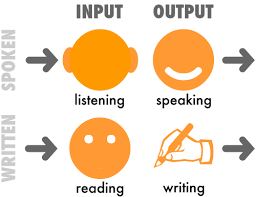Giving Excellent Presentations in Japan (Don’t Imitate Steve Jobs!)
November 27, 2017
In a lecture on presentations being given the other day to advanced foreign learners of Japanese, there was a student who imitated Steve Job’s presentation style, but the Japanese people attending gave him a low evaluation.
So, let’s take a look at some important points that non-Japanese people need to know when giving a presentation in Japanese.

Learn the orthodox Japanese style well
When giving presentation in Japanese, there will probably be people in the audience who do not understand English very well.
Japanese people of this type are not used to presentations of the type Steve Jobs would give.
Actually, most Japanese people are used to a very simple style like that in this video.
https://www.youtube.com/watch?v=G1dNSkGuCeg
Polish your presentation until you get it right
Advanced Japanese speakers should aim to give a perfect presentation just like a Japanese person.
Ideally, the presentation should be logical, informative, and easy for Japanese people to understand. Mid-level Japanese speakers should think of ways to compensate for their incomplete knowledge of Japanese.
First, try to gain the good will of your company.
To accomplish this, we recommend that you convey the disadvantages of products and services in addition to the advantages.
The reason is that honestly stating disadvantages in a frank appeal can easily gain the trust of Japanese people.
Practice your presentation
Make a video of your presentation and review it.
If you don’t have a video camera, use a ?Bandicam.
http://www.bandicam.com/main.php?from=jp
Get feedback from two Japanese people
You should ask your Japanese teacher about the accuracy of your Japanese.Particularly make sure that your particles and sentence ending expressions are correct.You should also ask the opinion of a business person regarding the content.

Good luck on your presentation!
When do you feel like going back to your own country?
November 27, 2017
Naturally, people who have decided to live in Japan, sometimes feel like they want to go home.
I saw an article about what non-Japanese people say when they are asked which times make them feel like going back home. I’ll tell you some of the things they said.

You can read the original Japanese article below.
http://news.mynavi.jp/column/gaikoku/052/
・When I want to see my friends and family
You can talk to them on Skype, but of course you would also like to have fun with them in person.
Try to make close friends in Japan so that you don’t get lonely!
・When I can’t express my feelings in Japanese
I also felt this way when I was living overseas. So, be sure to study your Japanese harder!
・When I can’t find a job other than teaching English conversation
In this day and age, I recommend trying to find an IT engineer job. The pay is good and a VISA is easy to get.
・When I get on a train fully packed with people
I don’t like it, either! (^_^;)

・When meetings at work drag on needlessly
One person said that even though Japanese people are very exact about starting on time, we don’t care so much about ending on time. We really are like that, aren’t we? Unfortunately, companies that have old corporate structures still hold lots of long meetings.

If there any of you out are lonely and don’t have any friends in Japan, please contact us.
How to get free Japanese audio examples?
November 21, 2017
“There is no audio example of the text that I want to read” is one of the problems foreigners often faced in self-studying Japanese. In this article, we will teach you how to solve this problem.
There are numerous audio materials that can be used for listening practices, such as textbooks attached with CDs and free YouTube movies. However, these are not the text that I want to read.
Japanese learners had no choice but to ask native Japanese like a Japanese instructor to read out the text.

Now, everyone can get audio examples of any text for free by using speech synthesis software.
Please visit the following site. (This page is only available in Japanese.)
- Choose a language
- Choose a voice actor
- Fill in the text you want to read out
The above three steps will help you get your own audio examples.

You can create your own text as below, it would be useful for practicing Japanese in various business settings such as interviews and presentations.
「大連のシステム会社でスマートフォンのソフトウェア開発に携わっておりました。」
“I have been engaged in software development for smartphones in a system company in Dalian.”
「本日はプレゼンの機会を頂き、誠にありがとうございます。当社の新商品をご紹介させて頂きます。」
“Thank you very much for the opportunity to make this presentation today, I will introduce our new products.”
「Keikoさん、僕と結婚して下さい。必ずあなたを幸せにします。」
“Keiko-san, please marry me! I will make you happy forever.”
Such private conversations are also okay.

Audio examples made by speech synthesis software are not perfect because it is mechanical sound, but I think it is sufficiently useful for self-studying.
Please try it!
Things People Learning Japanese Should Keep in Mind (Part 2)
November 15, 2017
In the article (Part 1), we had talked about three important things that people learning Japanese should keep in mind.
<1> Motivation does not last
<2> People are forgetful
<3> Retention rate according to the study method
This time we continue to discuss this topic related to learning Japanese.
<4> Take a balance of reading, writing, listening and speaking

Often listen to people who are learning a foreign language, like to practice speaking, but do not interested in studying grammar or practicing listening. However, taking a balance of each category is important in learning a foreign language. Especially people who are living in their own place to learn foreign languages, writing and speaking practices are probably not enough.
For example, there are many people studying Japanese for the Japanese language proficiency test (JLPT). However, most of the Japanese learners are not fluent in speaking, even if they are N1 qualified. On the contrary, there are a lot of foreigners living in Japan can speak fluent Japanese, but may not be so familiar with the basic grammar.
If there is a significant lack of writing and speaking practices (output), you are recommended to increase the opportunities of using Japanese.
If there is a significant lack of reading and listening practices (input), try to practice more reading and listening, even though the work might be boring.
<5> Don’t read Amazon reviews when choosing textbooks!

Many people will probably read online reviews, such as reviews from Amazon, before purchasing self-study textbooks. However, this method is not highly recommended because most of the reviews are simply written by common people, rather than experts, so the comments are very subjective. What’s more, common people will not take a few textbooks to make a detailed and objective comparative analysis, so this kind of information may not have reference values.
Instead, two methods are suggested as follows:
- Ask a professional Japanese teacher
- Ask a bookstore specializing in selling Japanese textbooks (SHOGAKUSHA, BONJINSHA, etc.)
Large bookstores like KINOKUNIYA, are also not highly recommended. As the bookstore staffs are not familiar with Japanese education, they may just introduce you the bestselling textbooks. However, the bestselling may not be the best. It is difficult to obtain appropriate advices from large bookstores. There are a variety of Japanese textbooks and learning materials available in specialty bookstores in Japan. It’s worth checking out!
The following site is recommended. A lot of teaching materials for learning business Japanese with commentary are available.
List of Business Japanese Textbooks
In addition, this site is particularly recommended to people who are learning IT business Japanese.
<6> How to find a good teacher?

What kind of teacher is a good teacher? It is difficult to say unequivocally because it varies from person to person. There is a very useful question that can clarify a Japanese teacher’s experience. Ask your teachers: “How many textbooks you are used as teaching tools?” If your teacher just answer one textbook, then you should be careful. In my opinion, a good teacher “can use appropriate materials and curriculum in accordance with student’s level and needs”. In other words, a teacher who has long experience in teaching Japanese, the number of textbooks using in teaching should be increased steadily. I know several Japanese-teaching experts who use more than 50 Japanese textbooks. If a Japanese teacher use more than 20 Japanese textbooks, he/she should be very enthusiastic about teaching Japanese.
We sincerely hope the above information is helpful to you.
Categories
Recent Posts
- I cannot keep up with meetings conducted in Japanese. Are there any good ways to study?
- Are there any good writing materials for business Japanese? (Three keys to developing business Japanese writing skills.)
- Are there any free materials available for studying business Japanese reading?
- Should I read newspapers for reading practice in business Japanese?
- Are there any good business magazines to practice reading business Japanese?
Archives
- August 2022
- June 2022
- May 2022
- April 2022
- March 2022
- February 2022
- January 2022
- October 2021
- January 2021
- August 2020
- July 2020
- June 2020
- May 2020
- April 2020
- March 2020
- February 2020
- January 2020
- December 2019
- November 2019
- October 2019
- September 2019
- August 2019
- July 2019
- June 2019
- May 2019
- April 2019
- March 2019
- February 2019
- January 2019
- December 2018
- November 2018
- October 2018
- September 2018
- August 2018
- July 2018
- June 2018
- May 2018
- April 2018
- March 2018
- February 2018
- January 2018
- November 2017
- October 2017
- July 2017
Tags
Social Media
- Prev
- Blog
- Next
